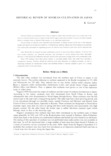Historical Review of Soybean Cultivation in Japan
Tropical agriculture research series : proceedings of a symposium on tropical agriculture researches
| ISSN | 03889386 |
|---|---|
| 書誌レコードID(総合目録DB) | AA00870529 |

本文フルテキスト
tars17-_135-142.pdf1.28 MB
Soybean which was introduced from China to Japan in olden times had been grown on a small scale in the farm as a crop for protein source in Japan. In the initial stage of cultivation soybean was grown in dikes of paddy fields or marginal areas of upland fields mainly on an individual plant basis.
Various kinds of cultivars were identified and developed, in taking account of the diet of the Japanese people. and special environmental conditions. Transplanting, topping, ridging and intercropping were generally and traditionally performed for regulating growth, for effective use of nutrients and water and for repeated land use.
After World War II, research has been undertaken actively to learn more about soybeans. Cultivars with cool weather tolerance, cyst nematode resistance, and resistance to several diseases have been developed. However, in this period the differences between record yields and actual average yields were considerably wide.
Since 1978 soybeans have been grown mainly in converted paddy fields, and yields have recorded a conspicuous increase. Cultivars should be endowed with such characters, as lodging resistance, as well as shattering resistance for mechanized culture and modified further to become adapted to grow on a canopy community basis in the near future.
Various kinds of cultivars were identified and developed, in taking account of the diet of the Japanese people. and special environmental conditions. Transplanting, topping, ridging and intercropping were generally and traditionally performed for regulating growth, for effective use of nutrients and water and for repeated land use.
After World War II, research has been undertaken actively to learn more about soybeans. Cultivars with cool weather tolerance, cyst nematode resistance, and resistance to several diseases have been developed. However, in this period the differences between record yields and actual average yields were considerably wide.
Since 1978 soybeans have been grown mainly in converted paddy fields, and yields have recorded a conspicuous increase. Cultivars should be endowed with such characters, as lodging resistance, as well as shattering resistance for mechanized culture and modified further to become adapted to grow on a canopy community basis in the near future.
| 刊行年月日 | |
|---|---|
| 作成者 | K. GOTOH |
| 公開者 | Japan International Research Center for Agricultural Sciences |
| 巻 | 17 |
| 開始ページ | 135 |
| 終了ページ | 142 |
| 言語 | eng |
